A Portable Spectrometric System for Quantitative Prediction of the Soluble Solids Content of Apples with a Pre-calibrated Multispectral Sensor Chipset
Abstract
:1. Introduction
2. Materials and Methods
2.1. Sample Preparation
2.2. Experimental Setup
2.3. Spectra Acquisition
2.4. Reference Analysis
2.5. Statistical Analysis
3. Results
3.1. Spectral Responses
3.2. PLSR Models for USB2000+ and AS7265x
3.3. Optimal MLR Model for AS7265x
4. Discussion
5. Conclusions
Author Contributions
Funding
Conflicts of Interest
References
- Nicolaï, B.M.; Defraeye, T.; De Ketelaere, B.; Herremans, E.; Hertog, M.L.A.T.M.; Saeys, W.; Torricelli, A.; Vandendriessche, T.; Verboven, P.; Ketelaere, B.D.; et al. Nondestructive measurement of fruit and vegetable quality. Annu. Rev. Food Sci. Technol. 2014, 5, 285–312. [Google Scholar] [CrossRef] [Green Version]
- Wang, H.; Peng, J.; Xie, C.; Bao, Y.; He, Y. Fruit quality evaluation using spectroscopy technology: A Review. Sensors 2015, 15, 11889–11927. [Google Scholar] [CrossRef] [Green Version]
- Nicolaï, B.M.; Beullens, K.; Bobelyn, E.; Peirs, A.; Saeys, W.; Theron, K.I.; Lammertyn, J. Nondestructive measurement of fruit and vegetable quality by means of NIR spectroscopy: A review. Postharvest Biol. Technol. 2007, 46, 99–118. [Google Scholar] [CrossRef]
- Pasquini, C. Near infrared spectroscopy: Fundamentals, practical aspects and analytical applications. J. Braz. Chem. Soc. 2003, 14, 198–219. [Google Scholar] [CrossRef] [Green Version]
- Civelli, R.; Giovenzana, V.; Beghi, R.; Naldi, E.; Guidetti, R.; Oberti, R. A simplified, light emitting diode (LED) based, modular system to be used for the rapid evaluation of fruit and vegetable quality: Development and validation on dye solutions. Sensors 2015, 15, 22705–22723. [Google Scholar] [CrossRef] [Green Version]
- Saeed, O.M.B.; Sankaran, S.; Shariff, A.R.M.; Shafri, H.Z.M.; Ehsani, R.; Alfatni, M.S.; Hazir, M.H.M. Classification of oil palm fresh fruit bunches based on their maturity using portable four-band sensor system. Comput. Electron. Agric. 2012, 82, 55–60. [Google Scholar] [CrossRef]
- Giovenzana, V.; Civelli, R.; Beghi, R.; Oberti, R.; Guidetti, R. Testing of a simplified LED based vis/NIR system for rapid ripeness evaluation of white grape (Vitis vinifera L.) for Franciacorta wine. Talanta 2015, 144, 584–591. [Google Scholar] [CrossRef] [PubMed]
- Jam, M.N.H.; Chia, K.S. Investigating the relationship between the reflected near infrared light and the internal quality of pineapples using neural network. Int. J. Adv. Sci. Eng. Inf. Technol. 2017, 7, 1389. [Google Scholar] [CrossRef]
- Turoni, T.R. DA Meter. Available online: https://www.trturoni.com/en/fruit-veg-ripeness-quality-control/da-meter/da-meter.5.html (accessed on 10 October 2020).
- Felix Instruments F-750 Produce Quality Meter. Available online: https://www.felixinstruments.com/food-science-instruments/portable-nir-analyzers/f-750-produce-quality-meter/ (accessed on 10 October 2020).
- Saranwong, I.; Sornsrivichai, J.; Kawano, S. Improvement of PLS calibration for brix value and dry matter of mango using information from MLR calibration. J. Near Infrared Spectrosc. 2001, 9, 287–295. [Google Scholar] [CrossRef]
- Lammertyn, J.; Peirs, A.; De Baerdemaeker, J.; Nicolaï, B. Light penetration properties of NIR radiation in fruit with respect to non-destructive quality assessment. Postharvest Biol. Technol. 2000, 18, 121–132. [Google Scholar] [CrossRef]
- Schaare, P.N.; Fraser, D.G. Comparison of reflectance, interactance and transmission modes of visible-near infrared spectroscopy for measuring internal properties of kiwifruit (Actinidia chinensis). Postharvest Biol. Technol. 2000, 20, 175–184. [Google Scholar] [CrossRef]
- AS7265x-Ams Datasheet [v1-04]. Available online: https://ams.com/documents/20143/36005/AS7265x_DS000612_1-00.pdf/08051c8a-a7f6-6231-7993-2d3fe0bf38b8 (accessed on 10 October 2020).
- Irfan, M.; Javed, M.; Raza, M.A. Comparison of shrinkage regression methods for remedy of multicollinearity problem. Middle East J. Sci. Res. 2013, 14, 570–579. [Google Scholar] [CrossRef]
- Qin, J.; Lu, R.; Peng, Y. Prediction of apple internal quality using spectral absorption and scattering properties. Trans. ASABE 2009, 52, 499–507. [Google Scholar] [CrossRef]
- Kawano, S.; Watanabe, H.; Iwamoto, M. Determination of Sugar content in intact peaches by near infrared spectroscopy with fiber optics in interactance mode. Engei Gakkai Zasshi 1992, 61, 445–451. [Google Scholar] [CrossRef] [Green Version]
- Whitney, A.W. A direct method of nonparametric measurement selection. IEEE Trans. Comput. 1971, 20, 1100–1103. [Google Scholar] [CrossRef]
- Travers, S.; Bertelsen, M.G.; Kucheryavskiy, S.V. Predicting apple (cv. Elshof) postharvest dry matter and soluble solids content with near infrared spectroscopy. J. Sci. Food Agric. 2014, 94, 955–962. [Google Scholar] [CrossRef] [PubMed]
- Yuan, L.; Cai, J.; Sun, L.; Han, E.; Ernest, T. Nondestructive measurement of soluble solids content in apples by a portable fruit analyzer. Food Anal. Methods 2016, 9, 785–794. [Google Scholar] [CrossRef]
- Guo, Z.; Wang, M.; Agyekum, A.A.; Wu, J.; Chen, Q.; Zuo, M.; El-Seedi, H.R.; Tao, F.; Shi, J.; Ouyang, Q.; et al. Quantitative detection of apple watercore and soluble solids content by near infrared transmittance spectroscopy. J. Food Eng. 2020, 279, 109955. [Google Scholar] [CrossRef]
- Fan, S.; Wang, Q.; Tian, X.; Yang, G.; Xia, Y.; Li, J.; Huang, W. Non-destructive evaluation of soluble solids content of apples using a developed portable Vis/NIR device. Biosyst. Eng. 2020, 193, 138–148. [Google Scholar] [CrossRef]
- Li, L.; Peng, Y.; Yang, C.; Li, Y. Optical sensing system for detection of the internal and external quality attributes of apples. Postharvest Biol. Technol. 2020, 162, 111101. [Google Scholar] [CrossRef]
- Liu, Y.; Chen, N.; Ma, Z.; Che, F.; Mao, J.; Chen, B. The changes in color, soluble sugars, organic acids, anthocyanins and aroma components in “Starkrimson” during the ripening period in China. Molecules 2016, 21, 812. [Google Scholar] [CrossRef] [PubMed] [Green Version]
- Peng, Y.; Lu, R. Prediction of apple fruit firmness and soluble solids content using characteristics of multispectral scattering images. J. Food Eng. 2007, 82, 142–152. [Google Scholar] [CrossRef]
- Lu, R. Multispectral imaging for predicting firmness and soluble solids content of apple fruit. Postharvest Biol. Technol. 2004, 31, 147–157. [Google Scholar] [CrossRef]
- Peng, Y.; Lu, R. Analysis of spatially resolved hyperspectral scattering images for assessing apple fruit firmness and soluble solids content. Postharvest Biol. Technol. 2008, 48, 52–62. [Google Scholar] [CrossRef]
- Rajkumar, P.; Wang, N.; EImasry, G.; Raghavan, G.S.V.; Gariepy, Y. Studies on banana fruit quality and maturity stages using hyperspectral imaging. J. Food Eng. 2012, 108, 194–200. [Google Scholar] [CrossRef]
- Khodabakhshian, R.; Emadi, B.; Khojastehpour, M.; Golzarian, M.R.; Sazgarnia, A. Development of a multispectral imaging system for online quality assessment of pomegranate fruit. Int. J. Food Prop. 2017, 20, 107–118. [Google Scholar] [CrossRef] [Green Version]
- El Masry, G.; Wang, N.; El Sayed, A.; Ngadi, M. Hyperspectral imaging for nondestructive determination of some quality attributes for strawberry. J. Food Eng. 2007, 81, 98–107. [Google Scholar] [CrossRef]
- Guthrie, J.; Walsh, K. Non-invasive assessment of pineapple and mango fruit quality using near infra-red spectroscopy. Aust. J. Exp. Agric. 1997, 37, 253–263. [Google Scholar] [CrossRef] [Green Version]
- Omar, A.F.; Atan, H.; Matjafri, M.Z. Peak response identification through near-infrared spectroscopy analysis on aqueous sucrose, glucose, and fructose solution. Spectrosc. Lett. 2012, 45, 190–201. [Google Scholar] [CrossRef]
- Liu, R.; Qi, S.; Lu, J.; Han, D. Measurement of soluble solids content of three fruit species using universal near infrared spectroscopy models. J. Near Infrared Spectrosc. 2015, 23, 301–309. [Google Scholar] [CrossRef]
- Ito, H. Potential of near infrared spectroscopy for nondestructive estimation of 0brix in strawberries. Acta Hortic. 2002, 751–754. [Google Scholar] [CrossRef]
- Rungpichayapichet, P.; Mahayothee, B.; Nagle, M.; Khuwijitjaru, P.; Müller, J. Robust NIRS models for non-destructive prediction of postharvest fruit ripeness and quality in mango. Postharvest Biol. Technol. 2016, 111, 31–40. [Google Scholar] [CrossRef]
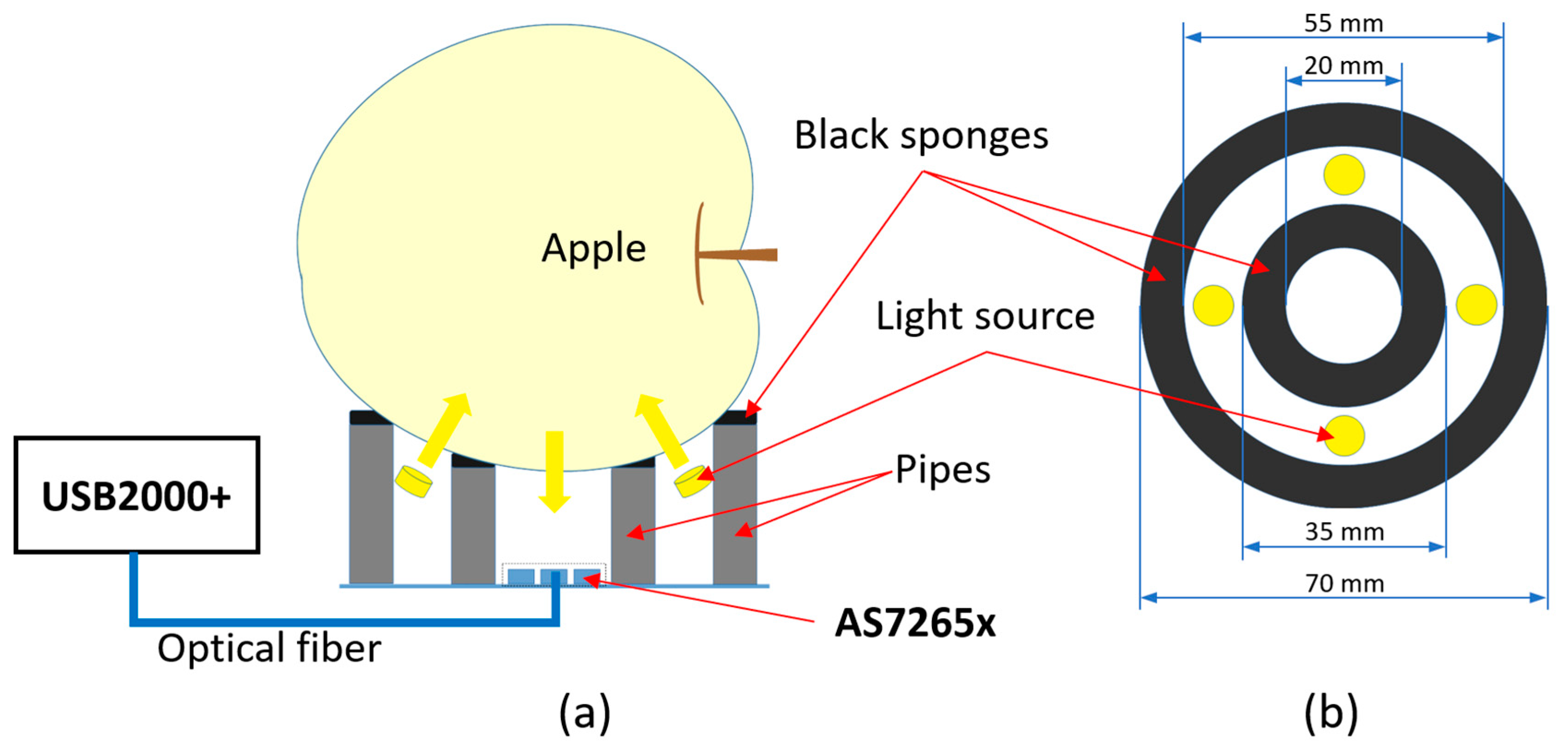
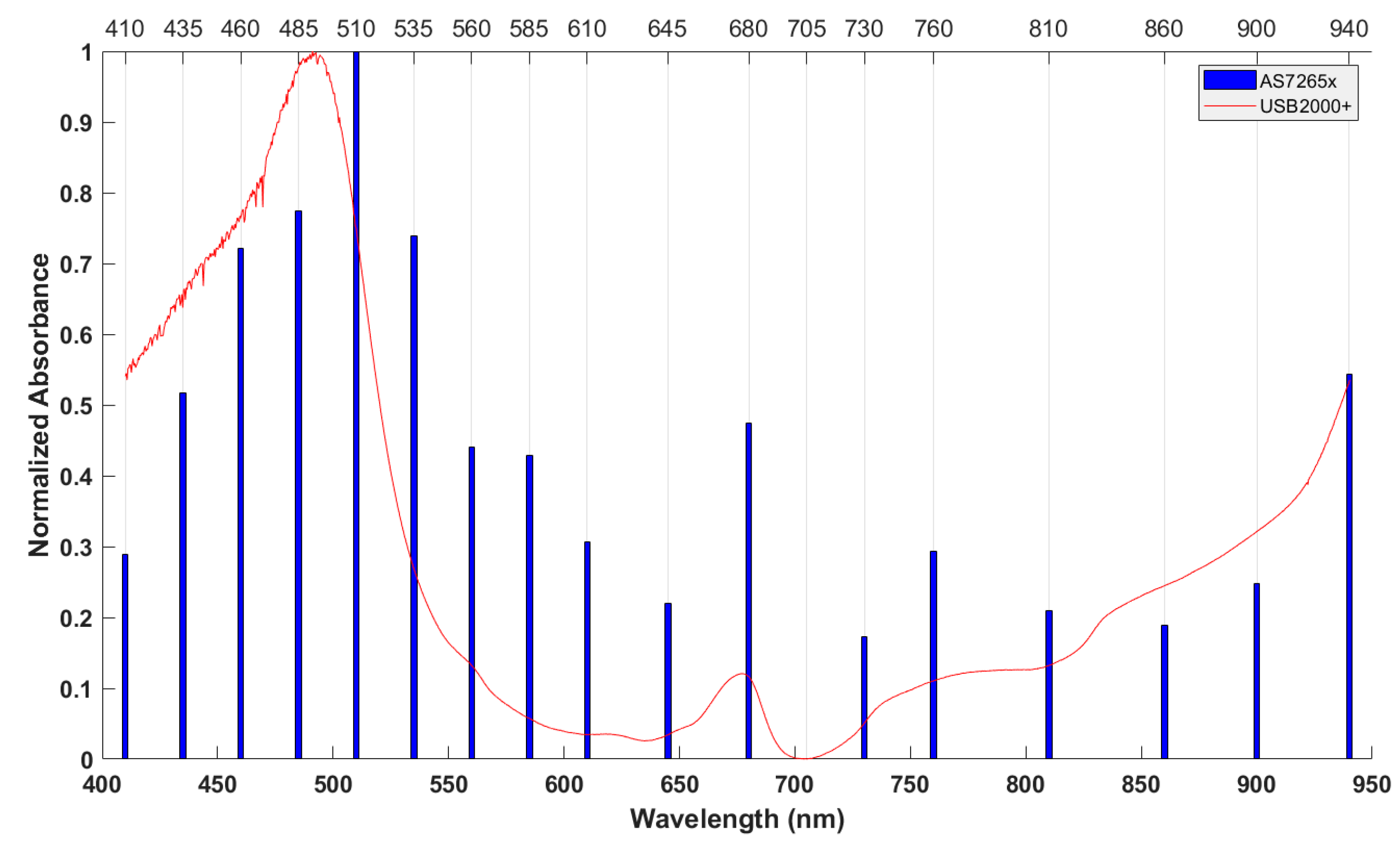
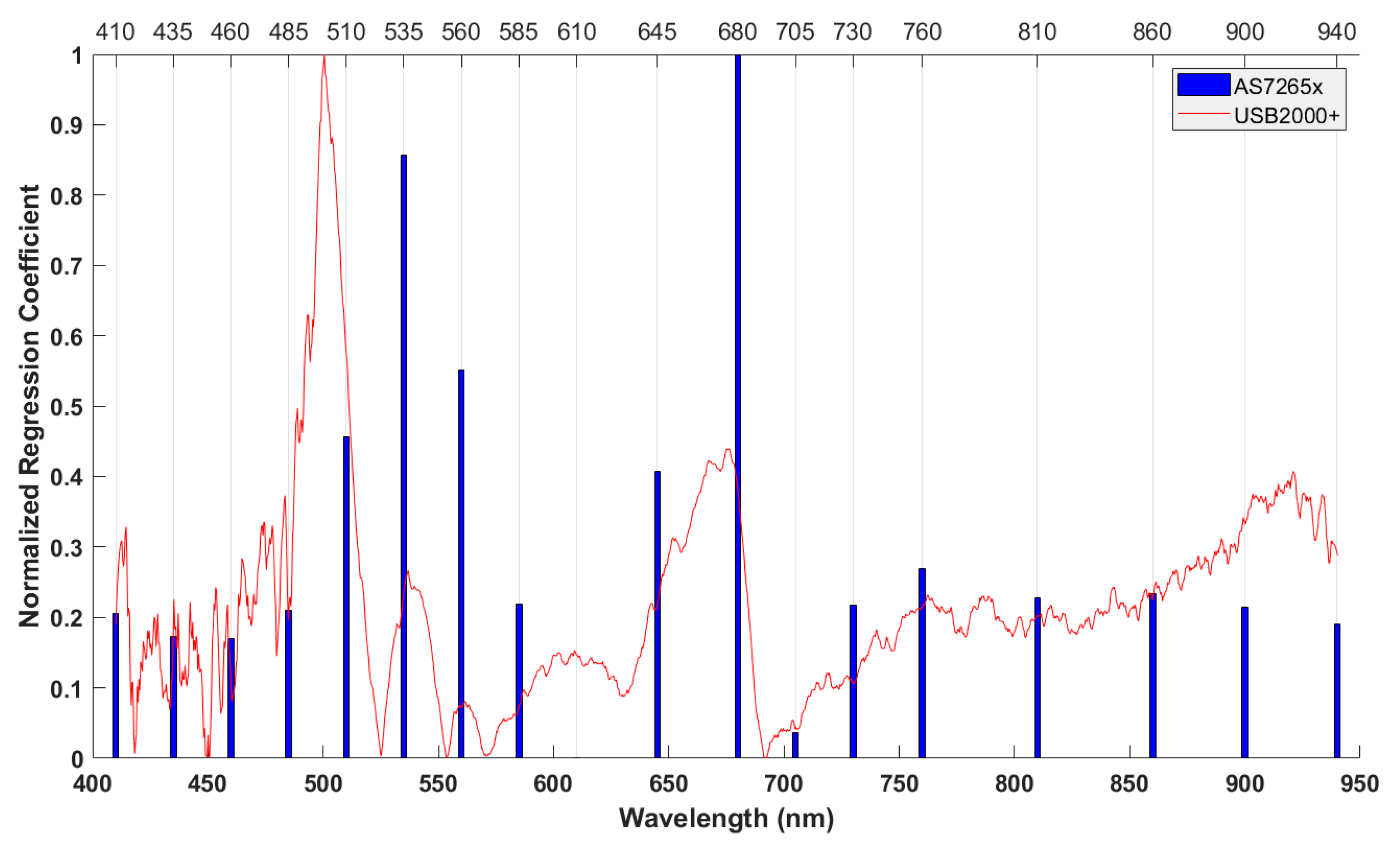
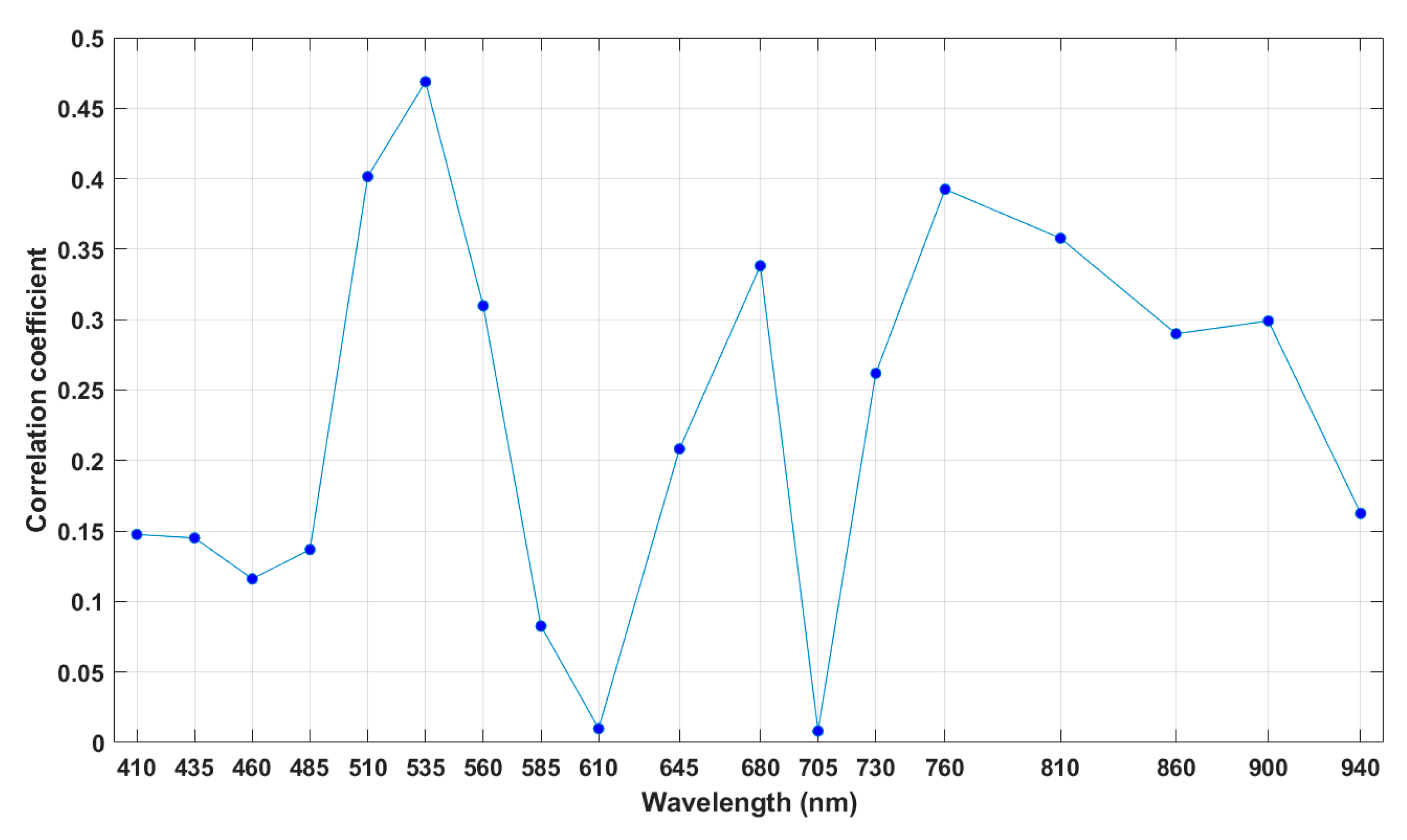
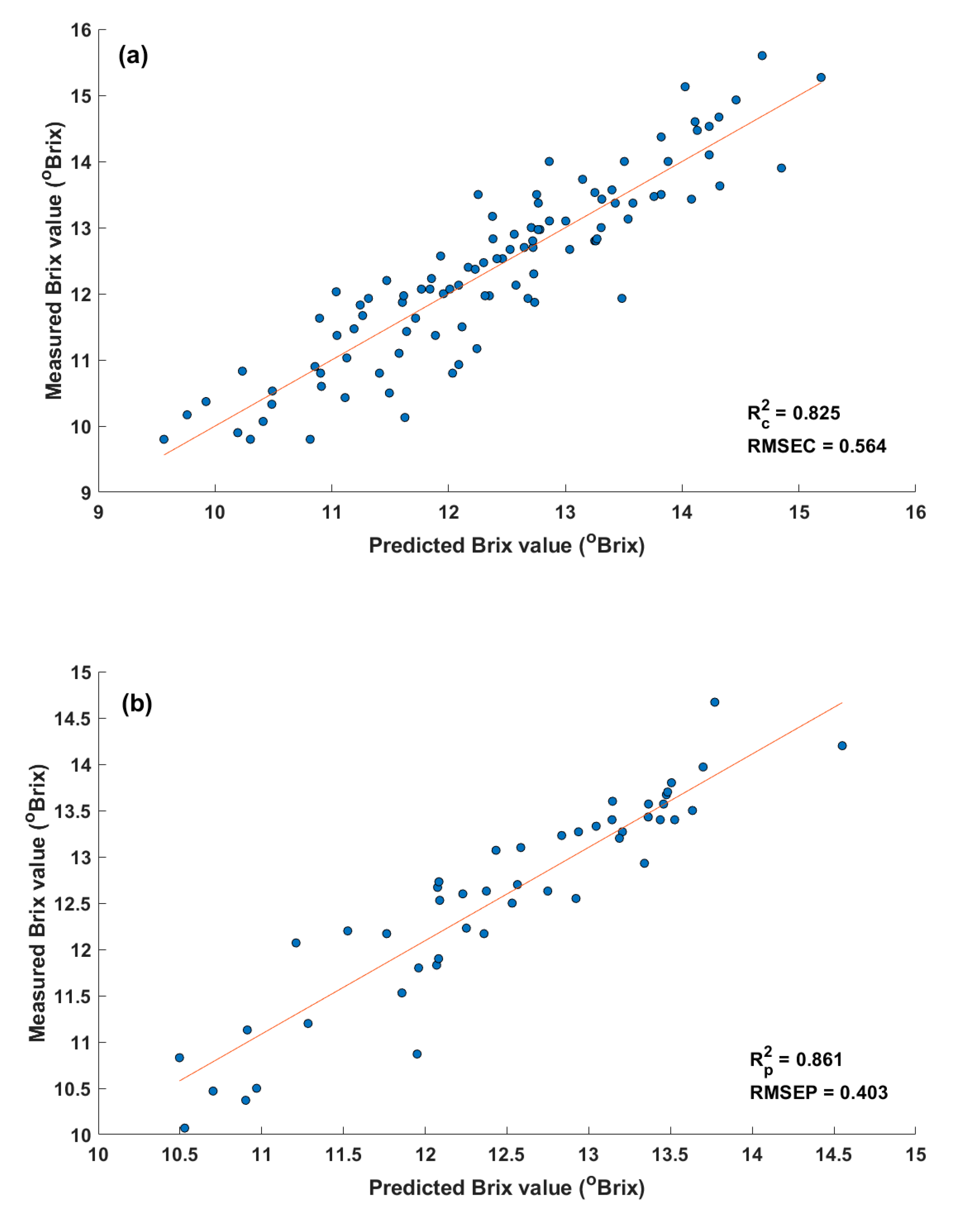
| Items | Calibration | Prediction |
|---|---|---|
| Number of samples | 100 | 48 |
| Range (°Brix) | 9.8–15.6 | 10.0–14.7 |
| Mean value (°Brix) | 12.55 | 12.38 |
| Standard deviation (°Brix) | 1.33 | 1.14 |
| Data | Latent Variable | Calibration | Prediction | ||
|---|---|---|---|---|---|
| Rc2 | RMSEC | Rp2 | RMSEP | ||
| USB2000+ | 4 | 0.816 | 0.568 | 0.876 | 0.398 |
| AS7265x | 2 | 0.803 | 0.599 | 0.852 | 0.416 |
| No. | Selected Waveband (nm) | Calibration | Prediction | ||
|---|---|---|---|---|---|
| Rc2 | RMSEC | Rp2 | RMSEP | ||
| 1 | 535 | 0.469 | 0.984 | 0.406 | 0.833 |
| 2 | 535, 680 | 0.775 | 0.641 | 0.769 | 0.519 |
| 3 | 535, 680, 900 | 0.808 | 0.591 | 0.846 | 0.424 |
| 4 | 535, 680, 900, 760 | 0.813 | 0.583 | 0.856 | 0.409 |
| 5 | 535, 680, 900, 760, 730 | 0.825 | 0.564 | 0.861 | 0.403 |
| 6 | 535, 680, 900, 760, 730, 460 | 0.827 | 0.562 | 0.849 | 0.420 |
| 7 | 535, 680, 900, 760, 730, 460, 610 | 0.829 | 0.558 | 0.864 | 0.398 |
| 8 | 535, 680, 900, 760, 730, 460, 610, 510 | 0.837 | 0.545 | 0.834 | 0.441 |
| 9 | 535, 680, 900, 760, 730, 460, 610, 510, 435 | 0.843 | 0.536 | 0.808 | 0.473 |
| 10 | 535, 680, 900, 760, 730, 460, 610, 510, 435, 705 | 0.844 | 0.534 | 0.808 | 0.474 |
| … | … | … | … | … | … |
| 18 | All 18 wavebands | 0.862 | 0.502 | 0.781 | 0.505 |
Publisher’s Note: MDPI stays neutral with regard to jurisdictional claims in published maps and institutional affiliations. |
© 2020 by the authors. Licensee MDPI, Basel, Switzerland. This article is an open access article distributed under the terms and conditions of the Creative Commons Attribution (CC BY) license (http://creativecommons.org/licenses/by/4.0/).
Share and Cite
Tran, N.-T.; Fukuzawa, M. A Portable Spectrometric System for Quantitative Prediction of the Soluble Solids Content of Apples with a Pre-calibrated Multispectral Sensor Chipset. Sensors 2020, 20, 5883. https://doi.org/10.3390/s20205883
Tran N-T, Fukuzawa M. A Portable Spectrometric System for Quantitative Prediction of the Soluble Solids Content of Apples with a Pre-calibrated Multispectral Sensor Chipset. Sensors. 2020; 20(20):5883. https://doi.org/10.3390/s20205883
Chicago/Turabian StyleTran, Nhut-Thanh, and Masayuki Fukuzawa. 2020. "A Portable Spectrometric System for Quantitative Prediction of the Soluble Solids Content of Apples with a Pre-calibrated Multispectral Sensor Chipset" Sensors 20, no. 20: 5883. https://doi.org/10.3390/s20205883
APA StyleTran, N.-T., & Fukuzawa, M. (2020). A Portable Spectrometric System for Quantitative Prediction of the Soluble Solids Content of Apples with a Pre-calibrated Multispectral Sensor Chipset. Sensors, 20(20), 5883. https://doi.org/10.3390/s20205883






